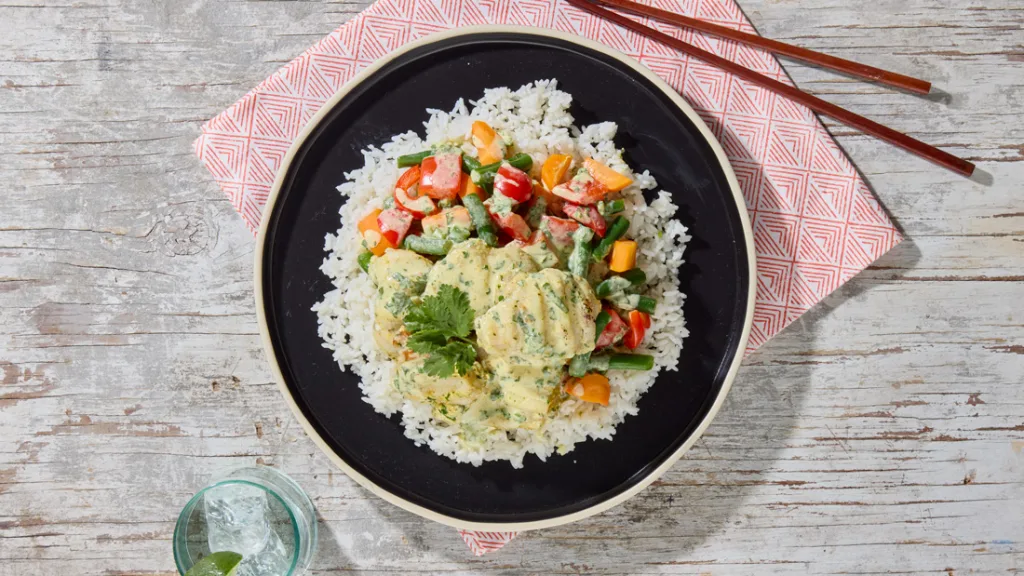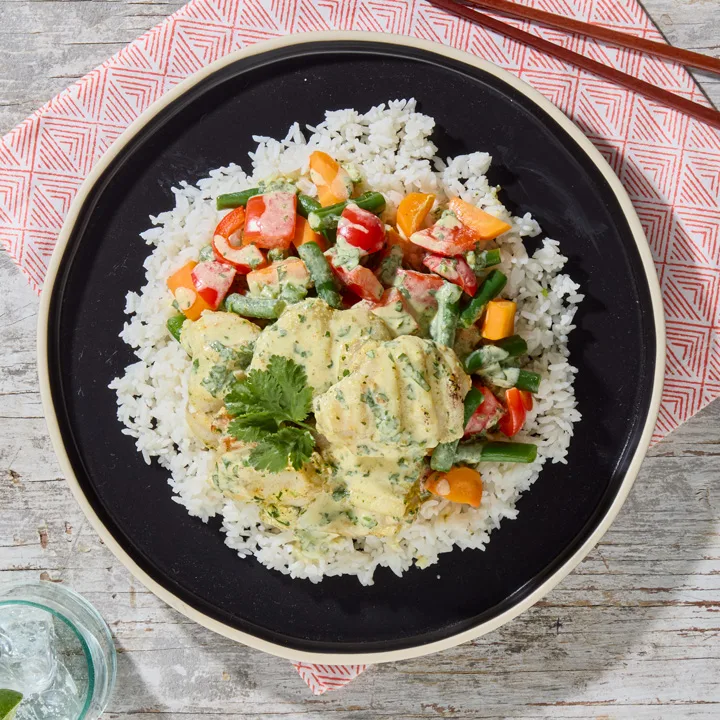Why Monkfish Is A Great Choice For Sustainability
When it comes to seafood, one of the most-asked questions is how do I know which are fish sustainable and sourced in a way that doesn’t negatively impact the environment? Organizations like the Monterey Bay Aquarium Seafood Watch are an invaluable resource for researching various marine species and the environmental impacts associated with them. But in a pinch, there’s one safe-bet rule you can follow to determine if your seafood is a good choice: Ask, is it local?

Monkfish coconut curry with vegtables and rice (recipe below)
Local seafood, whether wild-caught or farmed, comes with a number of advantages. First, it travels fewer miles, reducing the need for fuel and other resources. And since it covers less distance, it arrives faster and fresher to you. There’s also an increased likelihood that it comes directly from a family or small-scale fishery and passes through fewer middlemen, which supports the local economy. Additionally, local fisheries often abide by more stringent regulations and practices, taking greater measures to follow sustainable fishing methods that protect marine and land ecosystems, ensuring their health for generations to come.
In New York, where we’re gifted with a number of great, local seafood options, there’s one often-overlooked fish that stands out for its flavor, value, and abundance: monkfish. Currently, monkfish is above target population levels in the state’s Atlantic coastal waters. That means it’s plentiful and requires fewer resources to catch, making monkfish a sustainable and environmentally conscious seafood choice.
Because of its widespread range throughout the northeast, monkfish can be targeted by commercial fishermen close to their home ports. This eliminates the need for these fishermen to travel up and down the coastline in pursuit of their haul, significantly decreasing fuel consumption and emissions.
Monkfish has firm, white, sweet-tasting meat that has earned it the nickname “the poor man’s lobster.” It can be swapped into traditional lobster dishes, such as bisques and rolls. Additionally, monkfish is considerably cheaper than lobster, making it an excellent everyday option.
So, how to cook monkfish? Its firmness makes it suitable for slow-cooking methods that more delicate fish can’t handle, such as stews and chowders. It’s also great grilled, baked, broiled, or fried.
You can buy monkfish online at FreshDirect, where we offer 100% sustainable seafood. We work with local fisheries to source this fish, so you can always take comfort in knowing that it is direct from the source and at the peak of quality and freshness. At a time when overfishing, long supply chains, and environmentally-unsound practices are all real concerns, opting for transparently- and responsibly-sourced fish like local monkfish is one of the best ways to incorporate more seafood into your diet while doing what’s best for the environment.

Coconut Curry Monkfish Recipe
Serves 4
Monkfish’s firm texture makes it a great choice for stew-type recipes, which flaky fish are too delicate for. This curry is an excellent example of monkfish’s adaptability to different flavors and cooking methods.
What You’ll Need:
1 1/2 lb monkfish
Juice of 1 lemon (if cleaning fish)
One 13.5 ounce can coconut milk
Juice from 1 lime
1 tablespoon curry powder
1 teaspoon salt (plus 1 teaspoon more if cleaning)
1 jalapeño, minced*
1/4 cup cilantro, roughly chopped
Long-grain rice and vegetables, for serving.
*Tip: For less heat, remove seeds and light-colored pith from jalapeño before mincing
If the monkfish is covered in a thin, blueish protective layer, clean it first:
To remove the blue-silver film from the monkfish, grasp the tail end, and slip your thin, flexible knife into the fillet. You may have to scrape against the skin and cutting down the length of the fish by the tail end, pulling the film away with your thumb. Remove the fish and, if any pieces remain, slip your knife down the length of the remnant, pulling the blade up against the skin and cutting under its ends to turn it over.
To clean the fish, place it in large bowl and cover with cold water. Add 1 teaspoon of salt and juice of one lemon. Mix with your hands or a wooden spoon and let sit for one minute. Then rinse each fillet under cold water and place on a clean, dry side towel or paper towel.
What To Do:
Cut monkfish into 2-inch medallions. Place coconut milk, lime juice, curry powder, salt, jalapeño, and cilantro in a bowl and mix well. Remove 1/3 cup of mixture and set aside in a container (it will be used as a sauce for the fish after cooking).
Put the remaining coconut mixture in a zip-loc bag with the monkfish medallions. Let marinate for at least 1 hour (or ideally, up to overnight).
When ready to cook, heat a grill or saute pan over medium-high heat. Remove fish pieces from marinade and sear until cooked through, 5-7 minutes per side.
Serve over jasmine or other long-grain rice with vegetables on the side.
Recipe shared by Stefanie Sacks, MS, CNS, CDN
 RELATED
RELATED
FreshDirect Sourced: Great Gun Oysters
In Long Island’s Moriches Bay, Great Gun Oyster Farm is raising oysters that reflect the local terroir while contributing greatly to the sustainability and health of the waters along the Fire Island National Seashore.
